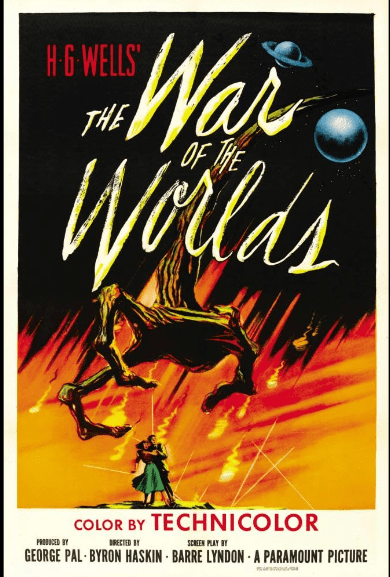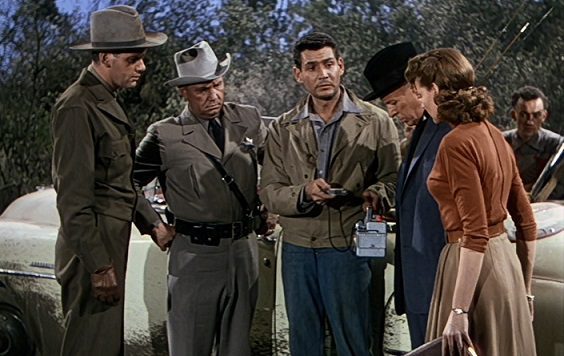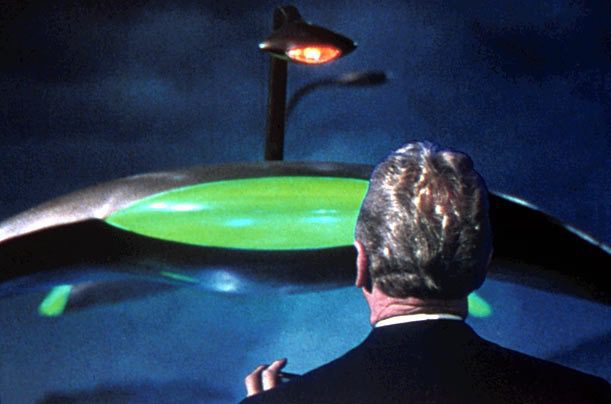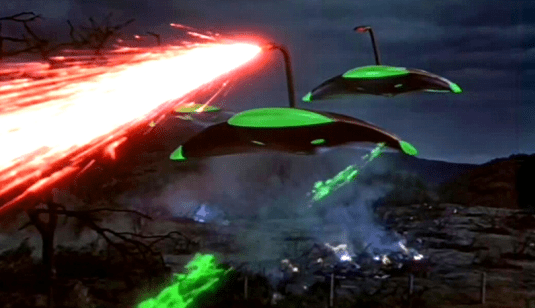The War of the Worlds is a science fiction film released in 1953, directed by Byron Haskin and produced by George Pal. Based on the 1898 novel of the same name by H.G. Wells (with screenplay by Barré Lyndon), it is considered one of the classic and influential movies in the science fiction genre.
Oddly enough, it might not make some people’s “Top 10” sci-fi movie lists, but it is preserved in the National Film Registry by the United States Library of Congress, who deem it “culturally, historically, or aesthetically significant.” The film’s plot revolves around the sudden and devastating invasion of Earth by technologically advanced Martians.
In fact, here they are now!
As you can see if you watched that clip, the Martians arrive in large, stylish-as-hell war machines equipped with powerful heat rays and other advanced weaponry. In addition to being creepy, H. G. Wells’s novel was, in fact, the first formally published alien invasion story, beginning with the haunting, ominous words:
“No one would have believed in the last years of the nineteenth century that this world was being watched keenly and closely by intelligences greater than man’s… Yet across the gulf of space, minds that are to our minds as ours are to those of the beasts that perish, intellects vast and cool and unsympathetic, regarded this earth with envious eyes, and slowly and surely drew their plans against us.”
Pretty spooky, right? Well, remember that this was written in 1898, well before the X-Files, and even well before the 1950s wave of alien invasion flicks! So, really, this alone makes the first adaptation of The War of the Worlds special.
“The War of the Worlds”: All-Out Assault

As the kick-ass aliens begin their assault, humanity is caught off guard and struggles to defend itself against the seemingly unstoppable invaders. The movie follows the experiences of a Los Angeles-based scientist named Dr. Clayton Forrester, played by Gene Barry, and his love interest Sylvia Van Buren, played by Ann Robinson. The story primarily focuses on their attempts to survive and evade the Martian onslaught while searching for a way to fight back against the alien invaders.
War of the Worlds was, and still is, notable for its impressive visual effects for its time, including the iconic Martian war machines and their destructive heat rays. The film’s special effects and production design were well-received, earning it an Academy Award for Best Visual Effects. One of the film’s most famous scenes is the depiction of the Martian war machines emerging from beneath the ground and attacking various locations, causing widespread panic and destruction.

The War of the Worlds Plays with Real-World Anxieties
The War of the Worlds captured the Cold War-era fears and anxieties about potential invasions from unknown and technologically superior forces, which were prevalent during the time of its release. Joyce A. Evans, author of Celluloid Mushroom Clouds: Hollywood And Atomic Bomb, noted that “[The] rapid proliferation [of science fiction films] presents one of the most interesting developments in post-World War II film history, for never in the history of motion pictures has any other genre developed and multiplied so rapidly in so brief a period.”
The 1953 version of War of the Worlds remains a classic in the science fiction genre and has inspired numerous adaptations, including a surprisingly gory TV series in 1988 (which also featured Ann Robinson returning to the role of Sylvia Van Buren). There was also a more recent 2005 film directed by Steven Spielberg starring Tom Cruise.
Of course, every article on this classic story needs to mention the radio drama by Orson Welles in 1938, which is said to have stirred panic among radio listeners. The story’s enduring appeal lies in its exploration of humanity’s vulnerability in the face of a seemingly unstoppable and technologically advanced threat.
Also, yes, Mystery Science Theater 3000 did borrow the name “Dr. Clayton Forrester” (Trace Beaulieu) for their mad scientist character, which is another element of this film’s legacy.

War of the Worlds (1953) is streaming now on Prime Video, ROKU Channel, Paramount+ and several other streaming services.
What are your thoughts on The War of the Worlds? Invade us in the comments below!
 PopHorror Let's Get Scared
PopHorror Let's Get Scared




